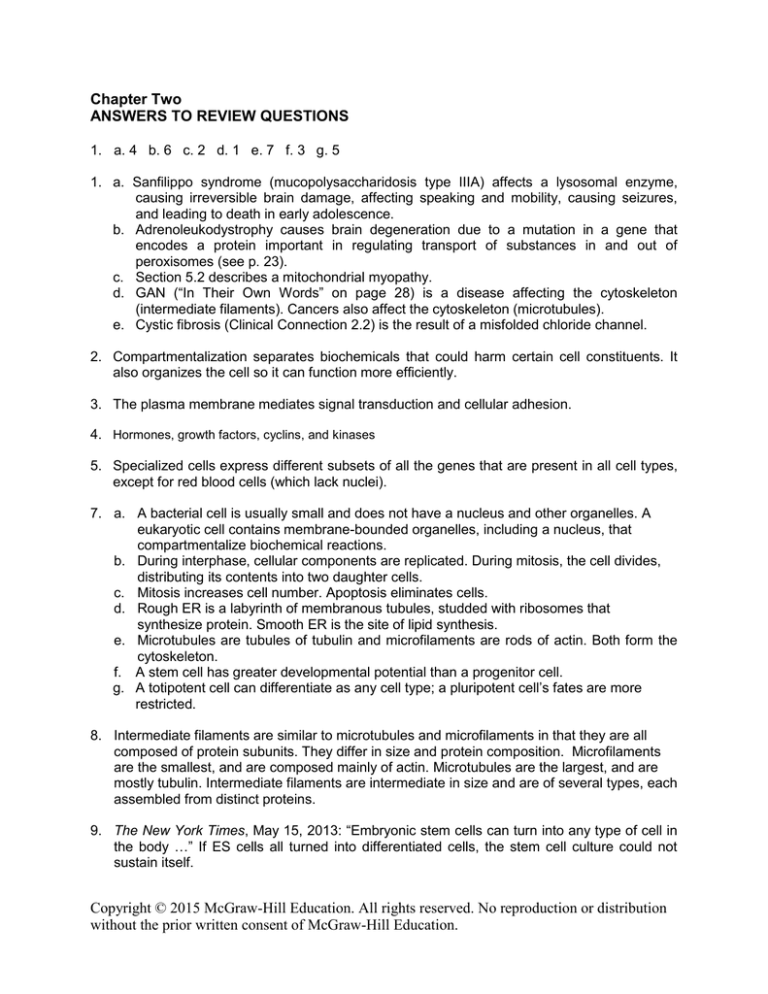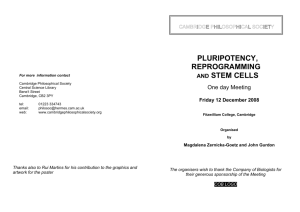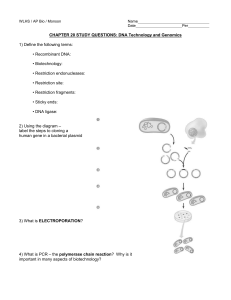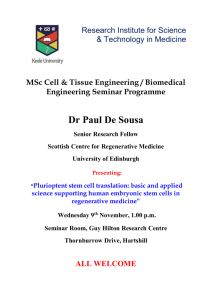
Chapter Two
ANSWERS TO REVIEW QUESTIONS
1. a. 4 b. 6 c. 2 d. 1 e. 7 f. 3 g. 5
1. a. Sanfilippo syndrome (mucopolysaccharidosis type IIIA) affects a lysosomal enzyme,
causing irreversible brain damage, affecting speaking and mobility, causing seizures,
and leading to death in early adolescence.
b. Adrenoleukodystrophy causes brain degeneration due to a mutation in a gene that
encodes a protein important in regulating transport of substances in and out of
peroxisomes (see p. 23).
c. Section 5.2 describes a mitochondrial myopathy.
d. GAN (“In Their Own Words” on page 28) is a disease affecting the cytoskeleton
(intermediate filaments). Cancers also affect the cytoskeleton (microtubules).
e. Cystic fibrosis (Clinical Connection 2.2) is the result of a misfolded chloride channel.
2. Compartmentalization separates biochemicals that could harm certain cell constituents. It
also organizes the cell so it can function more efficiently.
3. The plasma membrane mediates signal transduction and cellular adhesion.
4. Hormones, growth factors, cyclins, and kinases
5. Specialized cells express different subsets of all the genes that are present in all cell types,
except for red blood cells (which lack nuclei).
7. a. A bacterial cell is usually small and does not have a nucleus and other organelles. A
eukaryotic cell contains membrane-bounded organelles, including a nucleus, that
compartmentalize biochemical reactions.
b. During interphase, cellular components are replicated. During mitosis, the cell divides,
distributing its contents into two daughter cells.
c. Mitosis increases cell number. Apoptosis eliminates cells.
d. Rough ER is a labyrinth of membranous tubules, studded with ribosomes that
synthesize protein. Smooth ER is the site of lipid synthesis.
e. Microtubules are tubules of tubulin and microfilaments are rods of actin. Both form the
cytoskeleton.
f. A stem cell has greater developmental potential than a progenitor cell.
g. A totipotent cell can differentiate as any cell type; a pluripotent cell’s fates are more
restricted.
8. Intermediate filaments are similar to microtubules and microfilaments in that they are all
composed of protein subunits. They differ in size and protein composition. Microfilaments
are the smallest, and are composed mainly of actin. Microtubules are the largest, and are
mostly tubulin. Intermediate filaments are intermediate in size and are of several types, each
assembled from distinct proteins.
9. The New York Times, May 15, 2013: “Embryonic stem cells can turn into any type of cell in
the body …” If ES cells all turned into differentiated cells, the stem cell culture could not
sustain itself.
Copyright © 2015 McGraw-Hill Education. All rights reserved. No reproduction or distribution
without the prior written consent of McGraw-Hill Education.
10. Embryonic stem (ES) cells are pluripotent cells from the inner cell mass of a very early
stage embryo or derived from somatic cell nuclear transfer. Induced pluripotent stem (iPS)
cells are pluripotent cells created from non-pluripotent somatic cells through genetic
manipulation. Adult stem cells are found throughout the body from embryonic development
onward. They can divide and yield differentiated daughter cells and are important for cell
replacement. Pros and cons: ES cells are naturally pluripotent and self-renewing. Use of
hES cells is more controversial than that of iPS cells or adult stem cells and countries vary
in their policies regarding such research. The full potential of iPS and adult stem cells is not
yet known. Adult stem cells are multipotent rather than pluripotent. Potential risks involve
rejection of implanted somatic cells and causing cancer.
11. The microbiome is the population of non-human cells living in a human body.
12. Removing the bacteria that normally live in the human body can be very dangerous,
because many are required in our physiology, such as digestion.
13. The human genome and the microbiome are similar in that they both account for the DNA in
our bodies. They are different in that the DNA in the microbiome is within prokaryotic cells,
and our (human) DNA is in eukaryotic cells.
ANSWERS TO APPLIED QUESTIONS
1. a.
b.
c.
d.
e.
f.
Lack of cell adhesion can speed the migration of cancer cells.
Impaired signal transduction can block a message to cease dividing.
Blocking apoptosis can cause excess mitosis, and an abnormal growth.
Lack of cell cycle control can lead to too many mitoses.
If telomerase is abnormal, a cell might not stop dividing when it normally would.
A stem cell activated to divide would increase cell number.
2. Mitochondria
3. Peroxisome
4. A sodium channel regulates the movement of sodium into and out of cells. It is found in the
plasma membrane.
5. Lysosome
6. Cells in an embryo are rapidly dividing, not in a resting state.
7. A lysosomal storage disease results from deficiency or absence of an enzyme that normally
breaks down a specific biochemical. Providing the enzyme can reinstate that function.
Umbilical cord stem cells from an unaffected individual can provide cells that produce the
needed enzyme, but must do so in a way that reaches the affected area.
8. Induced pluripotent stem cells come from a person’s somatic cells, such as skin fibroblasts.
Adult stem cells are naturally found in the body.
9. a. Pluripotent b. adult stem cells
Copyright © 2015 McGraw-Hill Education. All rights reserved. No reproduction or distribution
without the prior written consent of McGraw-Hill Education.
10. Different microbiomes
ANSWERS TO WEB ACTIVITIES
1. Answers vary with website selected
2. Ciliopathies
ANSWERS TO FORENSICS FOCUS
1. DNA profiling could be used to see which illegal products shared DNA sequences with
relatives. For example, the sibling of a victim would share half of DNA sequences from his or
her white blood cells or cheek lining cells with the DNA in bone, because the genomes are
the same in different tissues of the same body.
ANSWERS TO CASE STUDIES AND RESEARCH RESULTS
1. Her cells cannot break down a specific type of molecule in her lysosomes, and so the
material accumulates, impairing cell functions. Taylor can no longer hear and has to be fed
with a tube.
2. Identify a group of men and measure the rate of telomere shrinkage at a time when stress is
minimal (perhaps sophomore year of college) and then again at a more stressful time (first
year after college), and record their perceptions of their comparative stress at both times.
3. Hannah’s own cells would give her the disease all over again.
4. This is a study of both metagenomics (the bacteria in a given physical location) and the
human microbiome (bacteria that got in the restroom from body parts).
5. a. Researchers can develop drinks of bacteria that would enable children to
maximize the nutrients that they can use from foods.
b. The study allowed malnutrition to happen, but attempted to be ethical by providing the
healthy diet as soon as one twin became ill.
c. Identical twins following the same diet can differ in nutritional status if the bacteria in
their digestive tracts differ in ways that affect nutrient absorption.
Copyright © 2015 McGraw-Hill Education. All rights reserved. No reproduction or distribution
without the prior written consent of McGraw-Hill Education.







